When Do Babies Start to Crawl: Tips & Activities to Encourage Crawling
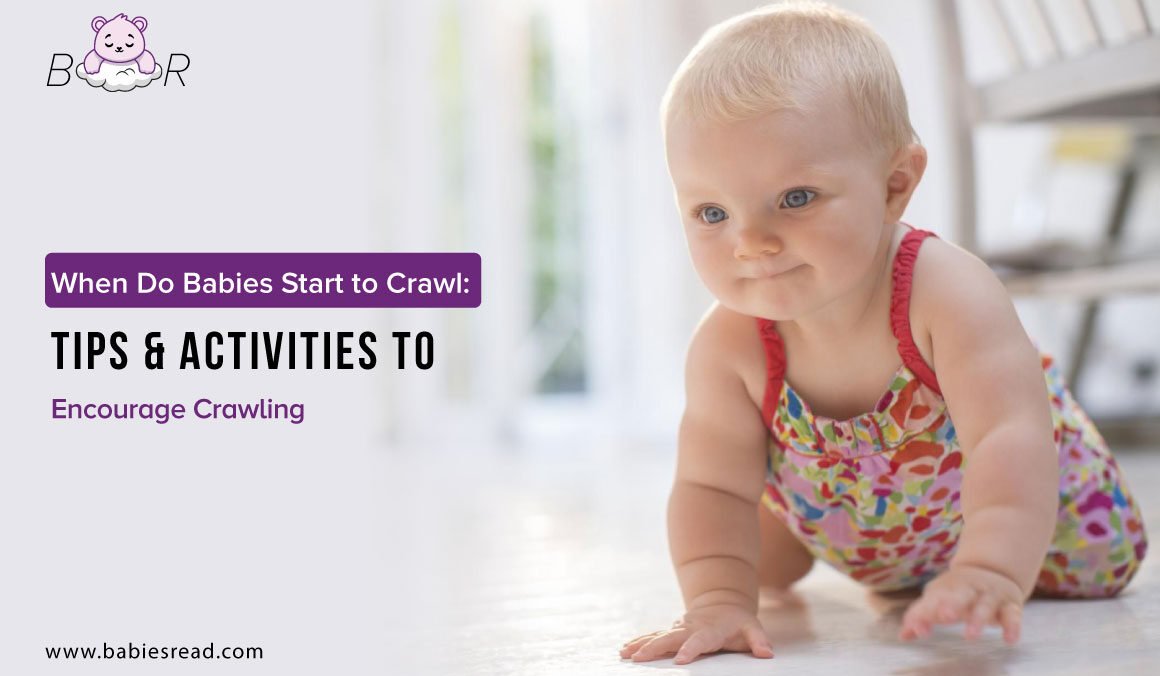
Every baby is unique therefore, the crawling age varies, but to give you an estimated, babies start to crawl between the age of 6 to 10 months old.
And that’s the shortest answer you’ll get to “when do babies start to crawl.”
Just FYI, my daughter started crawling when she was 7 months old.
That said, watching your baby crawling is something every parent is excited about, as the experience is just exhilarating.
It’s a fact that parents are always anxiously waiting for their babies to start crawling, and they’re always wondering at what age babies crawl.
Even though we don’t want our babies to grow up, it’s a beautiful moment to see them meet their age milestones and reach their crawling age, only to eventually get up and start walking.
But whatever the case may be, I assure you that the real adventure starts when your baby starts to crawl.
Babies learn how to crawl by developing motor skills, and while crawling, they explore their surroundings, look at everything with curiosity and try to interact with anything they find interesting.
But here’s the catch, crawling-age babies still need a little help perfecting their crawling, and that’s what we will discuss today.
As a whole new world of wonders opens up to them when babies start crawling, it can be fascinating and interactive for the parents as it is for their babies, but you need to help them learn how to crawl with a few activities.
Being aware of when you should start expecting your baby to crawl and streamlining a few activities and tips that can encourage your infant to start crawling is imperative.
Therefore, I’ve curated this blog to help you get all the information you need to know on baby crawling so let’s get down to business!
Table of Content
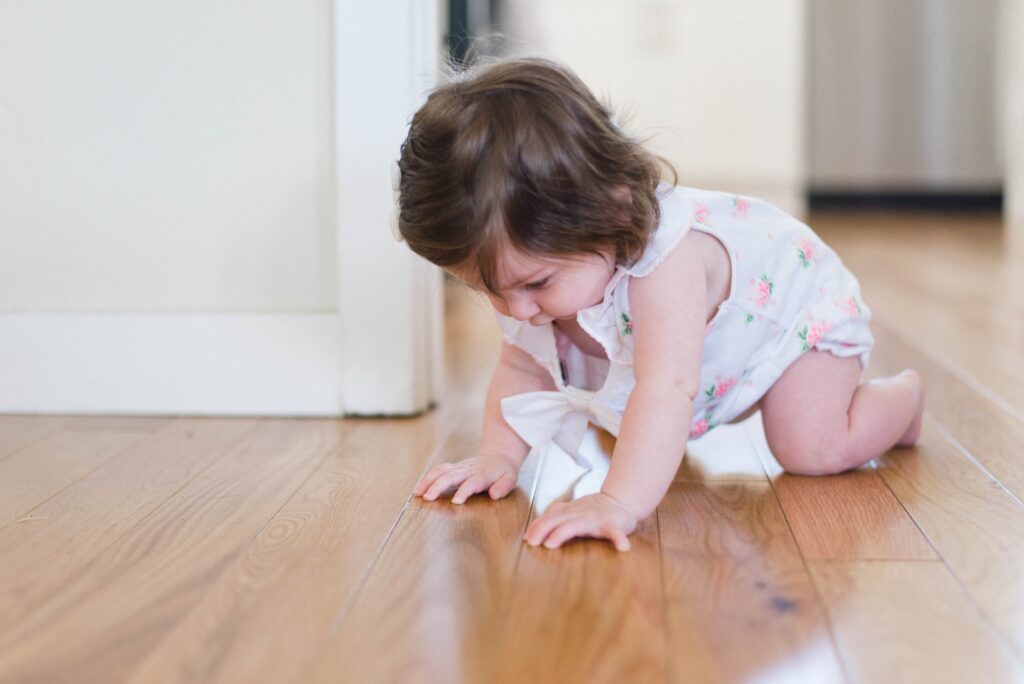
When Do Babies Start Crawling?
As mentioned earlier, babies start crawling when they are roughly around 7 to 10 months of age, but it is also quite common for them to reach this milestone a few months later.
Because every baby is unique so you can’t say for certain what age babies crawl.
If you’re concerned that your baby hasn’t started crawling yet, whereas your friend’s babies have started crawling – don’t worry!
Some babies skip crawling altogether and jump straight to taking their first steps, and that’s quite a development in my eyes.
As long as your baby shows interest in exploring their surroundings, playing with their toys, interacting with you, and walking by holding your hand or something, you should enjoy these moments.
But still, if you want to know when babies should start crawling, it’s never too late to give your pediatrician a visit.
A pediatrician would give you insights into your baby’s crawling age and development and precise advice on what you need to do to encourage your baby to crawl.
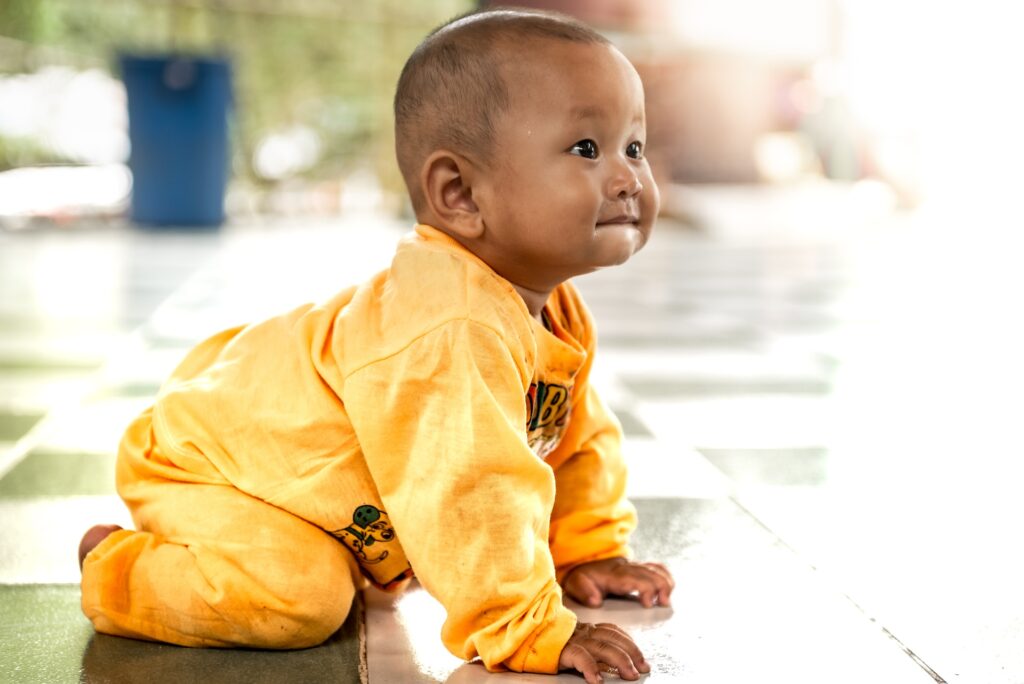
Why is Baby Crawling Important?
As the baby learns to crawl, a world of discoveries opens up for the little ones.
Everything they could only look at from afar comes into their reach.
Well, not everything, because you’ll be keeping most of the stuff that’s not safe out of the reach of your crawling baby.
But that will change when they’re a few months old and understand what’s safe for them and what’s not.
In addition, your baby develops independence as they start to crawl, and we don’t want them to be dependent, so that’s another reason babies need to start crawling.
However, learning this fine motor skill is no easy task. It takes the dynamic duo of the body and the mind to learn how to crawl while using cognitive and visual-spatial skills.
Crawling also helps develop depth perception in the baby, as they use their binocular vision to switch their focus between their hands and something far ahead.
Here are some other important developments that a crawling-age baby makes:
1. Sensory Development
Babies come into contact with a diversified range of textures (such as carpets, marble or wooden floors, grass, etc.) when they start to crawl.
Crawling also helps them develop their sense of balance, depth perception, visual tracking, and proprioception (i.e., body position and self-movements).
2. Motor Strength
Crawling strengthens the thigh, tummy, arms, shoulders, and the muscles of the legs and also increases joint strength. In short, when babies start to crawl, they develop the necessary skills to take their first steps.
3. Fine Motor skills
Another integral muscle group that gets trained as a child learns to crawl are the fingers.
Being on all fours stretches the fingers and helps the child develop fine motor functions such as holding-up pencils, drawing, playing with toys, and feeding themselves.
4. Problem-Solving and Memory
As the baby learns to crawl, they start to figure out how to reach out to the objects that catch its eye.
They try to move toward those objects, eventually training their minds to face challenges and solve problems that come their way.
This enables them to memorize different locations in the house, enhancing their working memory.
5. Brain Development
Moving around on all fours helps the baby learn the coordination between the opposite body parts – a great stimulus for the developing brain that eventually helps them perform multitasking at later stages in their lives.

Signs That Your Baby Is Ready To Crawl
The best way to figure out when babies start to crawl is simply by observing what they’re doing and how they’re moving in certain positions.
Recognizing these signs will help parents utilize encouraging techniques to kick-start their child’s crawling adventures. These signs may be as follows:
- The baby acquires an almost “push up” like position, supporting their weight on straight arms and legs.
- They drag their tummy across the floor using their arms.
- The transition phase from a crawling position into a sitting position.
- The baby starts to almost crawl with one leg bent but hasn’t learned to use the other leg yet.
- They are motivated to reach for objects by rolling around (keep them interested!)
- They rock back and forth on their knees.
- Your baby might also experience sleep disturbances right around this time. They might find it more interesting to explore their surroundings using their newfound motor skills in their cribs rather than relaxing.
If you notice your child exhibiting any of these signs, rest assured that you will be chasing after your crawling kid in a few weeks’ time.
This calls for baby-proofing your home to ensure a safe and secure place for your child to make the most of the newly developed motor skills.
What Are the Different Types of Crawling?
As your baby starts to crawl around and tries to support their weight on their own, their muscles strengthen and they eventually leanr how to balance themselves to start crawling efficiently around the house without support.
However, not every child crawls in the same manner, and there’s no right or wrong way to do it.
Here are a few types of crawling you can look out for in your baby:
1. Hands and Knees Crawl
The typical crawling pattern, common in almost all babies, is the Hands and Knees Crawl, or “Cross-Crawl” or “Creeping.”
The baby’s weight is on their hands and knees, and they move forward by lifting their opposite hand and knee simultaneously.
2. Hands and Feet Crawl
Instead of their knees, babies support their weight on their hands and feet with their elbows and knees kept straight.
This type of movement is also known as “Bear Crawl” or “Bear Walk.” Babies take this position during the transition from the crawling phase to the moment they stand on their own.
3. Belly Crawl
During Belly Crawl – also known as “Commando crawl” or “Army crawl” – the baby usually keeps their tummy low to the floor as they use both arms and legs to move forward.
Belly crawl is often witnessed before Hands and Knees Crawl. The baby might start with just using their arms to push themselves forward, but their legs soon tag along.
4. Scooting
The baby usually sits upright and drags their bottom forward during scooting. They might also use the assistance of a leg to move around more efficiently.
5. Rolling
Rolling is when the baby rolls around on their sides to move here and there.
It might seem a little dizzying, but as long as the tot is interested in getting from one point to the other, it is good to go!
6. The Crab Crawl
In this less common crawling style, the baby uses their hands to maneuver their body while keeping one leg bent and the other straight for speed.
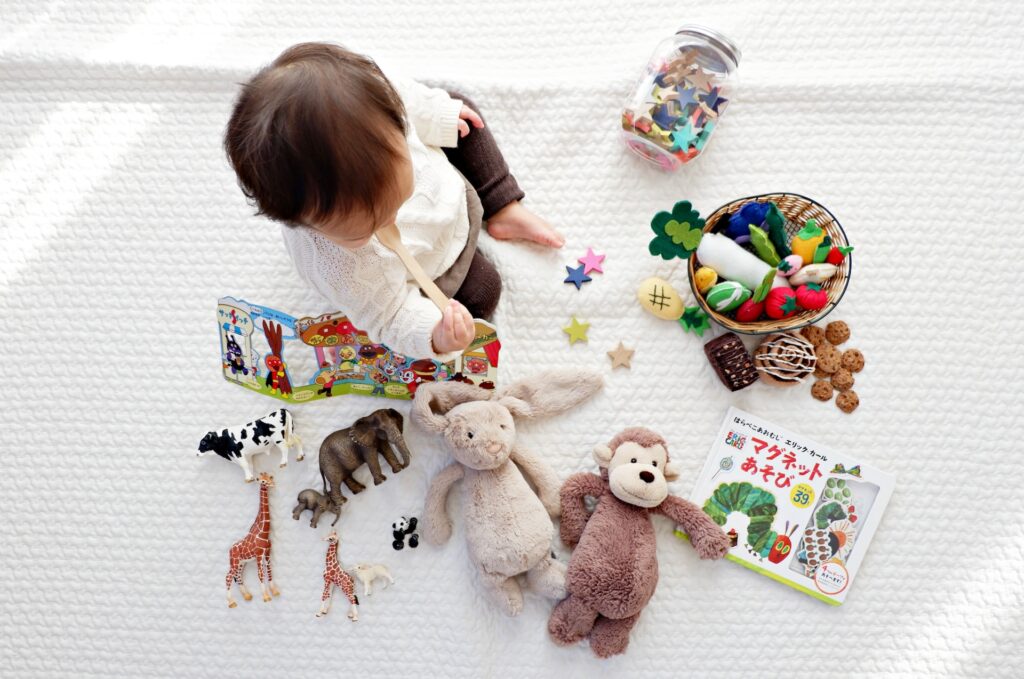
The 7 Stages Of Crawling That You Should Know
Crawling comprises 7 different developmental stages, and once you get to undersntad them, you’ll see that It’s amazing how babies learn to crawl.
But remember that your infant might skip certain stages or they might mix them up or tackle multiple of them simultaneously and it’s completely normal for them to do this.
Let’s get down to the seven stages of crawling now:
1. Tummy-Time
Ensuring your baby gets adequate tummy time daily is a must. It strengthens their neck and back muscles and prepares them for crawling. This is the pre-crawling phase.
2. Pivoting
Your child’s muscles might start moving around in circles on their belly as they strengthen. This is called the Pivoting stage.
3. Planking
Planking is when your baby assumes a plank position on their hands and toes or when they get on their hands and knees.
4. Swimming
In this phase, the baby tries to propel and strives to push the body forward, just like a swimmer inside a swimming pool.
5. Rocking
Once your child gets confident on all fours, they might start rocking back and forth in the planking position, similar to a horse ride.
6. Backward Scooting
When infants first start crawling, they might push backward using their arms before learning to coordinate their legs and arms to move forward.
7. Forward Scooting
In the last stage, babies start pushing themselves on their bellies to move forward. This typically happens when the babies are 8 months old.
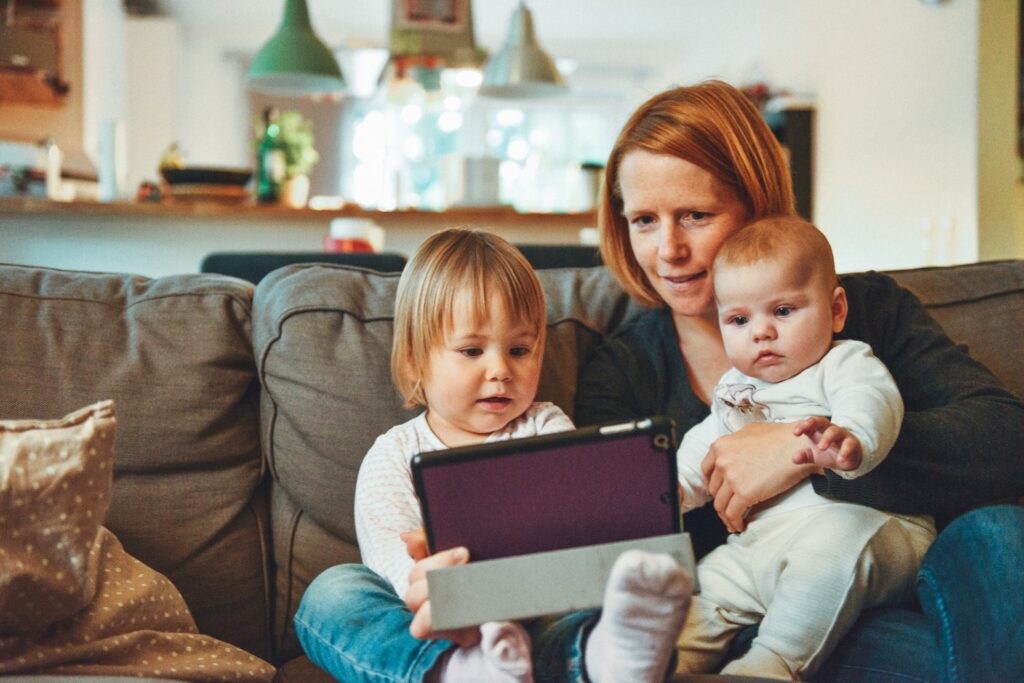
Tips And Activities That Encourage Crawling
Now that you’ve learned about the importance and the types of crawling as well as what kind of signs you can expect from your child as they get ready to crawl, it is time to give yourself a challenge and see if you can encourage your baby to start moving around by employing certain techniques.
These activities will motivate your child to become independent and start crawling and serve as an interactive and bonding session with your little one.
Some of these activities are as follows:
1. Tummy Time:
Let it be a two month old or a toddler, Tummy Time just happens to be the activiy that babies just love.
And since babies spend so much of their time on their backs lying, therefore giving them “tummy time” makes their neck and back muscles stronger.
The importance of placing babies on their bellies lies in the fact that those not made to practice tummy time may develop flat spots on the back of their heads, a condition called “positional plagiocephaly” or simply “Flathead.”
As per WHO guidelines, infants under 1 year should ideally spend 30 minutes on their tummies daily.
You can start this practice with 2-3-minute sessions each, a few times a day, and increase the duration as your child gets more comfortable.
If your baby doesn’t particularly enjoy this activity, try making it more interactive by placing toys in front of them.
2. Playtime:
This activity involves placing your child’s favorite toys barely within reach and encouraging them to move towards the toys.
Using affirming sounds as they reach for objects will greatly boost their confidence.
You can also show the child a hidden toy behind a pillow and let them find their way toward their object of interest.
As your child develops their motor skills and becomes more experienced, you can challenge them further by creating a makeshift maze with pillows and boxes, making them exercise their ability to navigate.
Always ensure that the place where you practice these activities are entirely safe for the baby, and never leave them unsupervised.

How To Baby-Proof Your Home
Creating a safe zone for your excited child is necessary, as unintentional injury is one of the leading causes of death in all age groups.
Even a minor accident or a small injury can scare off your kid and severely discourage them from exploring the surroundings.
Some tips to baby-proof your house are as follows:
- Cover all electrical outlets that are within the child’s reach.
- Install smoke alarms across the entire house and Carbon Monoxide detectors near sleeping areas.
- Ensure that all sharp corners around the house, such as those of furniture, doors, etc., are covered. You can use simple tape or buy specialized corner covers from online sources.
- Any small tables, chairs, nightstands, and other similar objects on the floor should be secured to ensure your baby doesn’t tip over them.
- Inspect the floor space regularly to remove any choking hazards such as small toys, utensils, screws, etc.
- Make sure to clean and disinfect the floors where your baby crawls more often to protect them from harmful germs.
- Always prioritize locking all doors and windows leading out of the house or to unsafe rooms to prevent your child from wandering outside.
- Similarly, ensure all cabinets around the house, especially those in the kitchen or the rest room are locked to prevent your child from coming into contact with toxic chemicals.
- Install gates at the top and bottom of staircases to prevent your baby from falling.
For all parents and caretakers, avoiding babies from all harm is always a top priority, and baby-proofing your house is the first step in accomplishing that since precaution is better than cure.
Disclaimer
The information presented in this article has been sourced from trusted medical and government websites and world-renowned journals. The links to all these sources are provided in the article above. Always refer to your healthcare provider or a pediatrician for a confirmed diagnosis and the correct treatment for your child’s ailments. Never take medical advice or self-medicate based on the information you find online.




![The 10 Best Baby Bouncers to Buy in 2024 [The Updated List]](https://babiesread.com/wp-content/uploads/2024/09/unnamed.jpg)

